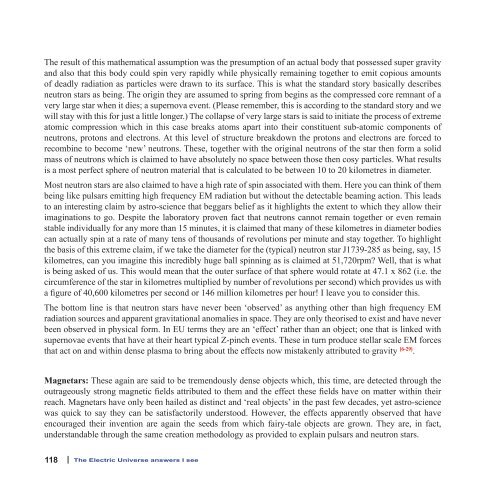A Beginner's View of Our Electric Universe - New
A Beginner's View of Our Electric Universe - New
A Beginner's View of Our Electric Universe - New
You also want an ePaper? Increase the reach of your titles
YUMPU automatically turns print PDFs into web optimized ePapers that Google loves.
The result <strong>of</strong> this mathematical assumption was the presumption <strong>of</strong> an actual body that possessed super gravity<br />
and also that this body could spin very rapidly while physically remaining together to emit copious amounts<br />
<strong>of</strong> deadly radiation as particles were drawn to its surface. This is what the standard story basically describes<br />
neutron stars as being. The origin they are assumed to spring from begins as the compressed core remnant <strong>of</strong> a<br />
very large star when it dies; a supernova event. (Please remember, this is according to the standard story and we<br />
will stay with this for just a little longer.) The collapse <strong>of</strong> very large stars is said to initiate the process <strong>of</strong> extreme<br />
atomic compression which in this case breaks atoms apart into their constituent sub-atomic components <strong>of</strong><br />
neutrons, protons and electrons. At this level <strong>of</strong> structure breakdown the protons and electrons are forced to<br />
recombine to become ‘new’ neutrons. These, together with the original neutrons <strong>of</strong> the star then form a solid<br />
mass <strong>of</strong> neutrons which is claimed to have absolutely no space between those then cosy particles. What results<br />
is a most perfect sphere <strong>of</strong> neutron material that is calculated to be between 10 to 20 kilometres in diameter.<br />
Most neutron stars are also claimed to have a high rate <strong>of</strong> spin associated with them. Here you can think <strong>of</strong> them<br />
being like pulsars emitting high frequency EM radiation but without the detectable beaming action. This leads<br />
to an interesting claim by astro-science that beggars belief as it highlights the extent to which they allow their<br />
imaginations to go. Despite the laboratory proven fact that neutrons cannot remain together or even remain<br />
stable individually for any more than 15 minutes, it is claimed that many <strong>of</strong> these kilometres in diameter bodies<br />
can actually spin at a rate <strong>of</strong> many tens <strong>of</strong> thousands <strong>of</strong> revolutions per minute and stay together. To highlight<br />
the basis <strong>of</strong> this extreme claim, if we take the diameter for the (typical) neutron star J1739-285 as being, say, 15<br />
kilometres, can you imagine this incredibly huge ball spinning as is claimed at 51,720rpm? Well, that is what<br />
is being asked <strong>of</strong> us. This would mean that the outer surface <strong>of</strong> that sphere would rotate at 47.1 x 862 (i.e. the<br />
circumference <strong>of</strong> the star in kilometres multiplied by number <strong>of</strong> revolutions per second) which provides us with<br />
a figure <strong>of</strong> 40,600 kilometres per second or 146 million kilometres per hour! I leave you to consider this.<br />
The bottom line is that neutron stars have never been ‘observed’ as anything other than high frequency EM<br />
radiation sources and apparent gravitational anomalies in space. They are only theorised to exist and have never<br />
been observed in physical form. In EU terms they are an ‘effect’ rather than an object; one that is linked with<br />
supernovae events that have at their heart typical Z-pinch events. These in turn produce stellar scale EM forces<br />
that act on and within dense plasma to bring about the effects now mistakenly attributed to gravity [6-29] .<br />
Magnetars: These again are said to be tremendously dense objects which, this time, are detected through the<br />
outrageously strong magnetic fields attributed to them and the effect these fields have on matter within their<br />
reach. Magnetars have only been hailed as distinct and ‘real objects’ in the past few decades, yet astro-science<br />
was quick to say they can be satisfactorily understood. However, the effects apparently observed that have<br />
encouraged their invention are again the seeds from which fairy-tale objects are grown. They are, in fact,<br />
understandable through the same creation methodology as provided to explain pulsars and neutron stars.<br />
11 | The <strong>Electric</strong> <strong>Universe</strong> answers I see


